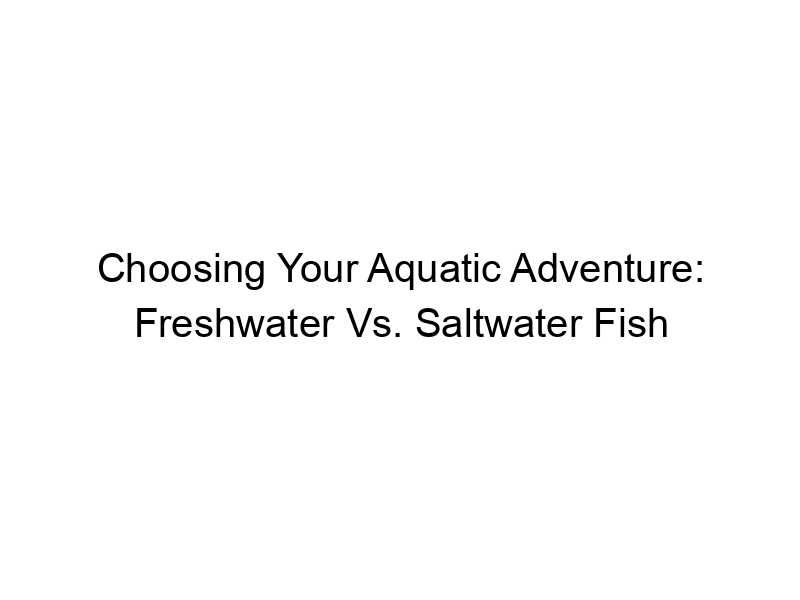So, you’re ready to dive into the fascinating world of aquarium keeping? The first, and perhaps most crucial, decision you’ll face is whether to embark on a journey with freshwater vs. saltwater fish. This comprehensive guide will explore the nuances of both, helping you determine which aquatic ecosystem best suits your lifestyle, experience level, and budget. We’ll delve into the differences in setup, maintenance, species selection, and the overall commitment involved, equipping you with the knowledge to make an informed choice.
Freshwater ecosystems encompass a vast array of habitats, from slow-moving rivers and tranquil ponds to fast-flowing streams and lush wetlands. The defining characteristic is the low salinity (salt concentration) of the water, typically less than 0.5 parts per thousand (ppt). This low salinity dictates the types of plants and animals that can thrive in these environments.
Diversity
of Freshwater Fish
The diversity of freshwater fish is astounding. From the vibrant colors of neon tetras and the majestic size of Oscars to the intricate patterns of betta fish, there’s a freshwater species to captivate every aquarist. This vast selection allows for exciting aquarium designs, ranging from densely planted community tanks to minimalist setups showcasing individual species.
Advantages of Freshwater Aquariums
Freshwater aquariums often represent a more accessible entry point into the hobby. They generally require less specialized equipment and are typically less expensive to maintain than saltwater tanks. The readily available resources and extensive online communities make troubleshooting and learning easier for beginners.
Understanding Saltwater Habitats
Defining Saltwater Environments
Saltwater habitats, encompassing oceans, seas, and coastal areas, are characterized by higher salinity levels, typically ranging from 30 to 40 ppt. This higher salinity profoundly impacts the physiology of the organisms that inhabit these environments, demanding specialized adaptations for survival.
Diversity of Saltwater Fish
The saltwater world boasts an equally impressive array of fish, showcasing an even greater range of colors, shapes, and sizes. From the graceful movements of angelfish to the striking beauty of clownfish, saltwater fish often exhibit more vibrant and diverse appearances. However, this beauty often comes with a greater level of complexity in care.
Advantages of Saltwater Aquariums
While more challenging to maintain, saltwater aquariums offer a unique sense of accomplishment and a window into a vastly different aquatic ecosystem. The beauty and complexity of a thriving reef tank, complete with corals and invertebrates, are unmatched in the aquarium world.
Comparing Setup and Maintenance
Freshwater Aquarium Setup
Setting up a freshwater aquarium is relatively straightforward. It involves choosing a tank, filter, heater, substrate, and appropriate plants and decorations. Water parameters like temperature and pH are crucial but easier to maintain than in saltwater tanks.
Saltwater Aquarium Setup
Setting up a saltwater aquarium is a significantly more involved process. It requires specialized equipment, including a protein skimmer, a sump, and often, a calcium reactor to maintain the delicate balance of the water chemistry. Accurate salinity, alkalinity, and other water parameters are essential for the well-being of saltwater inhabitants.
Maintenance Differences
Water changes are vital for both freshwater and saltwater tanks. However, maintaining optimal water parameters in saltwater aquariums demands more frequent testing and adjustments. Regular monitoring of salinity, pH, ammonia, nitrite, and nitrate levels is critical to prevent disease and maintain a healthy environment.
Species Selection: Freshwater vs. Saltwater
Choosing Freshwater Fish
The selection of freshwater fish is largely determined by tank size, compatibility, and desired aesthetic. Researching the specific needs of each species, including their temperament and water parameter requirements, is crucial for successful cohabitation.
- Beginner-friendly options: Neon tetras, platyfish, guppies
- More challenging species: Discus fish, angelfish, cichlids
Choosing Saltwater Fish
Selecting saltwater fish demands more advanced knowledge of their specific needs. Researching the compatibility of different species, their sensitivity to water parameters, and their dietary requirements is critical. Consider the space and compatibility needs of your chosen inhabitants.
- Beginner-friendly options (for experienced beginners): Damselfish, clownfish
- More challenging species: Angelfish, surgeonfish, butterflyfish
Cost Comparison: Freshwater vs. Saltwater
Initial Investment
Setting up a freshwater aquarium generally requires a lower initial investment compared to a saltwater aquarium. The equipment needed for freshwater is less specialized and therefore less expensive. Saltwater setups necessitate significantly more advanced and costly equipment.
Ongoing Costs
Maintaining a freshwater aquarium involves lower ongoing costs. Water changes are simpler and require less specialized products. Saltwater tanks demand consistent monitoring and adjustments, often involving expensive water test kits and chemical treatments.
Space Requirements and Aquarium Design
Freshwater Tank Sizes
Freshwater aquariums come in a wide variety of sizes, catering to various budgets and space limitations. Smaller tanks (e.g., 10-20 gallons) are suitable for small schools of fish, while larger tanks (e.g., 50+ gallons) accommodate larger or more numerous fish.
Saltwater Tank Sizes
Saltwater tanks are typically larger than freshwater tanks, as they house more complex ecosystems. Smaller nano-reefs can be maintained, but they require even more meticulous care. Larger tanks offer more stability and bio-diversity. The minimum size is usually 20 gallons or more.
Troubleshooting and Common Issues
Common Freshwater Problems
Common freshwater aquarium issues include algae growth, bacterial infections, and ammonia spikes. These problems are generally easier to address with readily available solutions and information. Regular maintenance and water changes are key to prevention.
Common Saltwater Problems
Saltwater aquariums are prone to a wider range of problems, including swings in water parameters, coral diseases, and invertebrate issues. Troubleshooting these problems often requires more advanced knowledge and specialized products.
The Commitment Factor
Time Commitment for Freshwater
Maintaining a freshwater aquarium requires a moderate time commitment. Regular water changes, feeding, and occasional cleaning are sufficient for most setups. More complex setups might demand more time.
Time Commitment for Saltwater
Saltwater aquariums demand a significantly greater time commitment. Regular water testing, parameter adjustments, and maintenance of specialized equipment are essential for success. This hobby necessitates dedication and consistent attention.
Beginner vs. Experienced Aquarist
Freshwater for Beginners
Freshwater aquariums are generally recommended for beginners due to their relatively simple setup and maintenance. The wealth of resources and supportive online communities make learning and troubleshooting easier.
Saltwater for Experienced Aquarists
Saltwater aquariums are best suited for experienced aquarists with a solid understanding of water chemistry, biological processes, and the specialized needs of saltwater organisms. The demanding nature of saltwater tanks makes it less ideal for beginners.
Advanced Techniques and Concepts
Freshwater Advanced Techniques
Advanced techniques for freshwater aquariums include breeding fish, creating intricate planted aquascapes, and managing complex ecosystems with numerous species. This requires more advanced knowledge of the needs of many different species.
Saltwater Advanced Techniques
Advanced techniques in saltwater aquariums involve reef keeping, propagating corals, managing complex filtration systems, and maintaining stable water chemistry across a range of parameters. The need for advanced knowledge and specialized equipment is paramount here.
Aquarium Accessories and Equipment
Essential Freshwater Equipment
Essential equipment for freshwater aquariums includes a filter, heater, substrate, lighting, and a thermometer. Other helpful accessories include an air pump, water test kit, and a net for maintenance.
Essential Saltwater Equipment
Essential equipment for saltwater aquariums includes a protein skimmer, sump, powerheads, a calcium reactor, and a high-quality lighting system. Water testing is significantly more important here too.
The Role of Live Rock and Coral
Live Rock in Saltwater Aquariums
Live rock is crucial in saltwater aquariums. It provides a habitat for beneficial bacteria, enhances filtration, and contributes to the overall aesthetic appeal. Live rock is one of the most important facets of a saltwater aquarium.
Coral in Saltwater Aquariums
Corals add beauty and complexity to saltwater aquariums. They require specific water parameters, lighting, and careful placement to thrive. Careful research into the individual needs of chosen corals is vital.
Frequently Asked Questions
What is the biggest difference between freshwater and saltwater fish?
The primary difference lies in their physiological adaptations to osmotic pressure. Freshwater fish have bodies adapted to constantly losing salt to their surroundings and actively take in salt. Saltwater fish face the opposite challenge, constantly losing water to their surroundings and actively expelling excess salt.
Which type of aquarium is more expensive to maintain?
Saltwater aquariums are significantly more expensive to maintain due to the cost of specialized equipment, water testing, and chemical treatments. The ongoing upkeep of a saltwater system demands a considerably larger investment compared to a freshwater setup.
Are freshwater fish easier to care for than saltwater fish?
Yes, generally speaking, freshwater fish are easier to care for than saltwater fish. The simpler equipment, less demanding water parameters, and wider availability of information make freshwater aquariums more beginner-friendly.
What are some common mistakes beginners make with freshwater aquariums?
Common beginner mistakes include overfeeding, neglecting regular water changes, failing to research species compatibility, and improper cycling of the tank. Proper research and attention to the basics are essential for success.
What are some common mistakes beginners make with saltwater aquariums?
Beginners often struggle with maintaining stable water parameters, neglecting the importance of live rock and proper filtration, and selecting incompatible species. Saltwater aquariums demand meticulous attention to detail and proper planning.
Final Thoughts
Choosing between a freshwater and a saltwater aquarium is a personal decision that hinges on your experience, commitment, and budget. Freshwater aquariums offer a gentler introduction to the hobby, while saltwater aquariums present a more challenging but rewarding journey into a diverse and captivating underwater world. Regardless of your choice, careful research and planning are vital for the success and well-being of your aquatic companions. Before you make your final choice, consider your lifestyle, your level of experience, and how much time and money you are willing to spend. With a thoughtful approach and the right information, you can create a thriving and beautiful aquatic environment that brings joy and wonder for years to come. Remember to always prioritize the well-being of your fish, and enjoy the incredible world of aquarium keeping!




